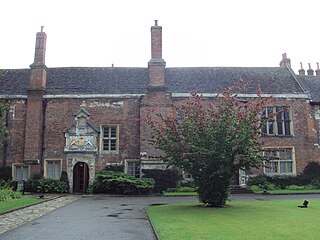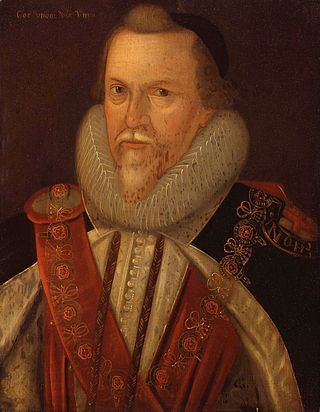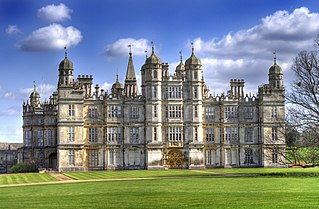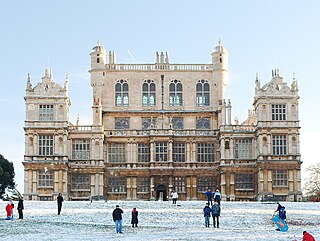
The King's Manor is a Grade I listed building in York, England, and is part of the University of York. It lies on Exhibition Square, in the city centre.

The King's Manor is a Grade I listed building in York, England, and is part of the University of York. It lies on Exhibition Square, in the city centre.
King's Manor was originally built to house the abbots of St Mary's Abbey, York. [1] The Abbot's house probably occupied the site since the eleventh century, but the earliest remains date from the fifteenth century. When the abbey was dissolved in 1539, Henry VIII instructed that it be the seat of the Council of the North. [1] It performed this role until the council was abolished in 1641. [1]
Thomas Cecil, Lord Burghley, was President of the Council of the North in 1603 when Elizabeth I died. He wrote to Sir Robert Cecil that he had moved out of the house, so that the new king, James VI and I, could stay there on his journey south to London. The house was empty of furnishings and "quite out of order". [2] Lord Burghley stocked the wine cellars and larders. [3] King James came to the "Manor of St Mary's" on 16 April 1603 and stayed in York for three days. [4] The buildings were upgraded and embellished by Thomas Wentworth, President of the North from 1628 to 1631, with new doorways and coats of arms. [5]
From 1667 to 1688, the manor was the residence of the Governor of York. During the Glorious Revolution of 1688, the Governor, Sir John Reresby, 2nd Baronet, remained loyal to the King, James II, but a party of armed men, led by Thomas Osborne, Earl of Danby, captured the Manor and the City of York, and held them for William of Orange. After 1688, the building was hired out to private tenants until the nineteenth century, when it was taken over and expanded by the Yorkshire School for the Blind. [1]
For a detailed description of the history and architecture of the building, perhaps the best source is that contained in the RCHME Inventory of the City of York, Volume IV. [6]
In April 2022 there were reports of criminal damage to the manor. It was reported that several windows had been broken and that blood was found at the scene, presumed to have been caused by broken glass. [7]
On the departure of the Blind School in 1958, the manor was acquired by York City Council, who leased it to the university in 1963. [1] The main university later moved to the Heslington Campus. From 1966, the principal academic department to use the manor was the Institute of Advanced Architectural Studies (IoAAS). [8] The IoAAS was a leading UK provider of mid-career education for architects and related professionals, specialising latterly in architectural conservation studies. The main public room of the manor is the Huntingdon Room, used for courses and meetings. As well as the IoAAS, there were several other departments in the King's Manor, the main ones being the Centre for Medieval Studies, a Language Teaching centre and the Design Unit (an architectural practice, but part of the IoAAS). The building also housed six university staff flats. The Dining Room provided an important place for the meeting of ‘town and gown’, especially in the early years of the university. Following the closure of the IoAAS in 1997, the main occupant became the Department of Archaeology (including the Archaeology Data Service), plus the Centre for Medieval Studies and the Centre for Eighteenth Century Studies. [1]

Kirkstall Abbey is a ruined Cistercian monastery in Kirkstall, north-west of Leeds city centre in West Yorkshire, England. It is set in a public park on the north bank of the River Aire. It was founded c. 1152. It was disestablished during the Dissolution of the Monasteries under Henry VIII.

Fountains Abbey is one of the largest and best preserved ruined Cistercian monasteries in England. It is located approximately 3 miles (5 km) south-west of Ripon in North Yorkshire, near to the village of Aldfield. Founded in 1132, the abbey operated for 407 years, becoming one of the wealthiest monasteries in England until its dissolution, by order of Henry VIII, in 1539.

Robert Cecil, 1st Earl of Salisbury, was an English statesman noted for his direction of the government during the Union of the Crowns, as Tudor England gave way to Stuart rule (1603). Lord Salisbury served as the Secretary of State of England (1596–1612) and Lord High Treasurer (1608–1612), succeeding his father as Queen Elizabeth I's Lord Privy Seal and remaining in power during the first nine years of King James I's reign until his own death.

The Council of the North was an administrative body first set up in 1484 by King Richard III of England, to improve access to conciliar justice in Northern England. This built upon steps by King Edward IV of England in delegating authority in the north to Richard, duke of Gloucester, and in establishing the Council of Wales and the Marches.

Glastonbury Abbey was a monastery in Glastonbury, Somerset, England. Its ruins, a grade I listed building and scheduled ancient monument, are open as a visitor attraction.

Newton Abbot is a market town and civil parish on the River Teign in the Teignbridge District of Devon, England. Its 2011 population of 24,029 was estimated to reach 26,655 in 2019. It grew rapidly in the Victorian era as the home of the South Devon Railway locomotive works. This later became a major steam engine shed, retained to service British Railways diesel locomotives until 1981. It now houses the Brunel industrial estate. The town has a race course nearby, the most westerly in England, and a country park, Decoy. It is twinned with Besigheim in Germany and Ay in France.

Thomas Cecil, 1st Earl of Exeter, KG, known as Lord Burghley from 1598 to 1605, was an English politician, courtier and soldier.

The Abbey of St Mary is a ruined Benedictine abbey in York, England and a scheduled monument.

An English country house is a large house or mansion in the English countryside. Such houses were often owned by individuals who also owned a town house. This allowed them to spend time in the country and in the city—hence, for these people, the term distinguished between town and country. However, the term also encompasses houses that were, and often still are, the full-time residence for the landed gentry who dominated rural Britain until the Reform Act 1832. Frequently, the formal business of the counties was transacted in these country houses, having functional antecedents in manor houses.

Burghley House is a grand sixteenth-century English country house near Stamford, Lincolnshire. It is a leading example of the Elizabethan prodigy house, built and still lived in by the Cecil family and is Grade I listed.

The Tudor architectural style is the final development of medieval architecture in England and Wales, during the Tudor period (1485–1603) and even beyond, and also the tentative introduction of Renaissance architecture to Britain. It followed the Late Gothic Perpendicular style and, gradually, it evolved into an aesthetic more consistent with trends already in motion on the continent, evidenced by other nations already having the Northern Renaissance underway Italy, and especially France already well into its revolution in art, architecture, and thought. A subtype of Tudor architecture is Elizabethan architecture, from about 1560 to 1600, which has continuity with the subsequent Jacobean architecture in the early Stuart period.

Theobalds House in the parish of Cheshunt in the English county of Hertfordshire, north of London, was a significant stately home and (later) royal palace of the 16th and early 17th centuries.
Cecil House refers to two historical mansions on The Strand, London, in the vicinity of the Savoy. The first was a 16th-century house on the north side, where the Strand Palace Hotel now stands. The second was built in the early 17th century on the south side nearly opposite, where Shell Mex House stands today.

Revesby Abbey was a Cistercian monastery near the village of Revesby in Lincolnshire, England. The abbey was founded in 1143 by William de Roumare, Earl of Lincoln, and the first monks came from Rievaulx Abbey.

Worksop Manor is a Grade I listed 18th-century country house in Bassetlaw, Nottinghamshire. It stands in one of the four contiguous estates in the Dukeries area of Nottinghamshire. Traditionally, the Lord of the Manor of Worksop may assist a British monarch at his or her coronation by providing a glove and putting it on the monarch's right hand and supporting his or her right arm. Worksop Manor was the seat of the ancient Lords of Worksop.

Sir Walter Cope of Cope Castle in the parish of Kensington, Middlesex, England, was Master of the Court of Wards, Chamberlain of the Exchequer, public Registrar-General of Commerce and a Member of Parliament for Westminster.

Louth Park Abbey was a Cistercian abbey in Lincolnshire, England. It was founded in 1139 by the Bishop Alexander of Lincoln as a daughter-house of Fountains Abbey, Yorkshire.

Prodigy houses are large and showy English country houses built by courtiers and other wealthy families, either "noble palaces of an awesome scale" or "proud, ambitious heaps" according to taste. The prodigy houses stretch over the periods of Tudor, Elizabethan, and Jacobean architecture, though the term may be restricted to a core period of roughly 1570 to 1620. Many of the grandest were built with a view to housing Elizabeth I and her large retinue as they made their annual royal progress around her realm. Many are therefore close to major roads, often in the English Midlands.

The Abbey of Saint Mary de Pratis, more commonly known as Leicester Abbey, was an Augustinian religious house in the city of Leicester, in the East Midlands of England. The abbey was founded in the 12th century by the Robert de Beaumont, 2nd Earl of Leicester, and grew to become the wealthiest religious establishment within Leicestershire. Through patronage and donations the abbey gained the advowsons of countless churches throughout England, and acquired a considerable amount of land, and several manorial lordships. Leicester Abbey also maintained a cell at Cockerham Priory, in Lancashire. The Abbey's prosperity was boosted through the passage of special privileges by both the English Kings and the Pope. These included an exemption from sending representatives to parliament and from paying tithe on certain land and livestock. Despite its privileges and sizeable landed estates, from the late 14th century the abbey began to suffer financially and was forced to lease out its estates. The worsening financial situation was exacerbated throughout the 15th century and early 16th century by a series of incompetent, corrupt and extravagant abbots. By 1535 the abbey's considerable income was exceeded by even more considerable debts.

The Institute of Advanced Architectural Studies (IoAAS), University of York, United Kingdom, was a post-graduate Institute primarily specialising in providing mid-career education and research, largely for architects and others in related professions. The history and activities of the IoAAS are recorded by the Borthwick Institute for Archives, University of York, who also hold much documentary material. The Institute's activities were also recorded in the Vice Chancellor's Annual Reports to the University Court, typically. The Institute took a broad view of the nature of architecture that extended to management, building science, design problems in specialized building types, building economics, architectural history, conservation, landscape and townscape. Its target audience was the architectural and allied professions.